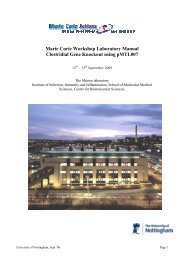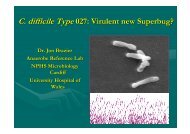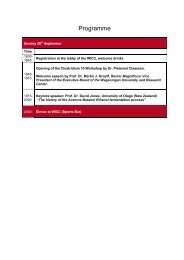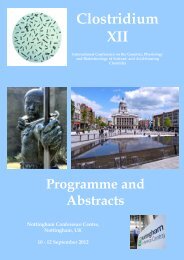abstract book - Clostridia
abstract book - Clostridia
abstract book - Clostridia
Create successful ePaper yourself
Turn your PDF publications into a flip-book with our unique Google optimized e-Paper software.
PHYLOGENETIC ANALYSIS OF CLOSTRIDIUM BOTULINUM TYPE<br />
A BY MULTI-LOCUS SEQUENCE TYPING<br />
Eric A. Johnson 1 , Mark J. Jacobson 1 , Guangyun Lin 1 , Thomas S.<br />
Whittam 2<br />
1 Department of Bacteriology, Food Research Institute, University of<br />
Wisconsin-Madison, Madison, WI, 53706 USA<br />
2 National Food Safety & Toxicology Center, Michigan State University,<br />
East Lansing, MI 48824-1314 USA<br />
Clostridium botulinum comprises a heterogeneous group of<br />
neurotoxigenic clostridia for which the phylogeny and evolutionary<br />
relationships are poorly understood. C. botulinum type A has recently<br />
been shown to produce multiple neurotoxin subtypes, suggesting that it<br />
is not monophyletic as previously reported, but is comprised of distinct<br />
lineages. The elucidation of these evolutionary relationships<br />
necessitates the use of experimental methods that can distinguish<br />
Clostridium lineages, which are time and cost effective, and can be<br />
accurately and reproducibly employed in different laboratories. Multi-<br />
Locus Sequence Typing (MLST) has been successfully used as a<br />
reproducible and discriminating system in the study of eukaryotic and<br />
prokaryotic evolutionary biology, and for strain typing of various<br />
bacteria. In this study, MLST was applied to evaluate the evolutionary<br />
lineages in the serotype A group of C. botulinum. For MLST analysis,<br />
we initially evaluated fourteen housekeeping genes (gapdh, tuf, sod,<br />
oppB, hsp60, dnaE, aroE, pta, 23S rDNA, aceK, rpoB, 16S rDNA, mdh,<br />
and recA) for amplification and sequence analysis. In the first phase of<br />
the analysis, thirty C. botulinum type A strains producing subtype<br />
BoNTs A1 - A4 were examined. Results of this pilot study suggested<br />
that seven of the genes (mdh, aceK, rpoB, aroE, hsp60, oppB, and<br />
recA) could be used for elucidation of evolutionary lineages and strain<br />
typing. These seven housekeeping genes were successfully applied for<br />
the elucidation of lineages for 73 C. botulinum type A strains, which<br />
resulted in 24 distinct sequence types (STs). This strategy should be<br />
applicable to phylogenetic studies and typing of other C. botulinum<br />
serotypes and Clostridium species.<br />
39
















